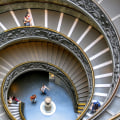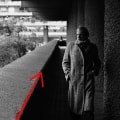The Rule of Thirds is one of the oldest and most trusted composition techniques used in documentary photography and wedding photography. It's simple yet powerful principles have been used for centuries to create stunning works of art. This comprehensive guide will provide you with all the information you need to master this technique and create photos and designs that stand out from the crowd. We'll cover how to use the Rule of Thirds, the benefits it offers for wedding photography, camera settings to best utilize this composition tool, and some tips and tricks to help you make the most of this documentary photography composition tool.
So, let's get started!
What Is the Rule of Thirds?
The Rule of Thirds is a popular composition technique used by photographers to create visually striking images for wedding photography. It's based on the principle that an image should be divided into nine equal parts, with the subject of the photo located at one of the intersecting points. This method helps to create a balanced and aesthetically pleasing composition that will draw the eye of the viewer. To use the Rule of Thirds, you need to divide the image into thirds both horizontally and vertically using two horizontal lines and two vertical lines. The intersection of these lines creates four points where your subject should be placed for the best effect. This technique helps to create an interesting and dynamic photo that is more visually appealing than a photo where the subject is in the center. The Rule of Thirds can be used in any type of photography, from landscapes to portraits, and it is especially useful when shooting in urban settings. By following this rule, photographers can create shots with a sense of depth and movement that will capture the attention of viewers.Using the Rule of Thirds in Urban Settings
The Rule of Thirds is a powerful composition technique that can be applied to a variety of settings, including urban ones. By following the Rule of Thirds, photographers can create balanced, aesthetically pleasing images that draw the eye of the viewer. However, it is important to take into account the unique characteristics of an urban setting when using the Rule of Thirds. When using the Rule of Thirds in an urban environment, it is important to consider the placement of important elements such as buildings and streets.For example, a street scene can be divided into thirds using the Rule of Thirds, with the street running along the bottom third and buildings filling up the top two thirds. This helps create a balanced composition that emphasizes the architecture and enhances the overall aesthetic. Additionally, it is important to consider the lighting of a scene when applying the Rule of Thirds. For example, a sunny day will produce different results than an overcast one.
In order to make the most of the light available, photographers should adjust their compositions accordingly. When using the Rule of Thirds in urban settings, it is also important to be aware of potential pitfalls. For example, a scene may appear unbalanced if there are too many elements competing for attention in one area. Additionally, photographers should avoid placing their subject too close to the center of an image, as this can create a distracting composition. Photographers should also be aware of potential distractions in their scene such as signs, people, or other elements that can take away from the overall composition. By taking into account these tips and techniques, photographers can use the Rule of Thirds in urban settings with confidence and create visually striking images.
With practice and experimentation, photographers can learn how to master this composition technique and create stunning works of art.
Tips for Using the Rule of Thirds in Urban Settings
When it comes to creating stunning compositions in urban settings, the Rule of Thirds is an invaluable tool. With this technique, photographers can divide an image into nine equal parts, with the subject of the photo located at one of the intersecting points. This creates a balanced and aesthetically pleasing composition that draws the eye of the viewer. In this section, we'll discuss some tips for using the Rule of Thirds in urban settings.Tip 1: Look for Lines and Patterns
Urban settings are often filled with interesting patterns, shapes, and lines.
As you look through your viewfinder, try to find objects that can be used to create an interesting composition. Look for lines that lead the eye towards your main subject and use them to draw attention to it. Objects like telephone poles, fences, and stairs can help to create an eye-catching composition.
Tip 2: Use Reflections
Reflections are a great way to add interest and depth to an image. Look for reflective surfaces such as puddles, windows, and mirrors in urban settings.
You can use them to create interesting images that utilize the Rule of Thirds. As you frame your shot, make sure to keep the subject on one of the intersecting points.
Tip 3: Look Up
Don't forget to look up! When shooting in urban settings, there are often interesting shapes and patterns that can be seen from above. Try looking up at buildings and other structures to find interesting compositions that utilize the Rule of Thirds. This is also a great way to add depth to your images.
Tip 4: Utilize Symmetry
Symmetry is another great way to incorporate the Rule of Thirds into your images.
Look for symmetrical objects such as doors, windows, or statues and frame them within your composition. Utilizing symmetry can help to create a balanced composition that will draw the viewer's eye.
Composition Techniques to Use with the Rule of Thirds
The Rule of Thirds is a powerful composition technique that can be used to create aesthetically pleasing images. However, it's not the only technique available – there are several other composition techniques that can be used in combination with the Rule of Thirds for even more striking results. Symmetry is one of the most popular composition techniques used in photography.This technique involves creating a balanced and symmetrical image by using elements that are equal in size and shape, such as lines and curves. This technique can be used to create a sense of order and harmony in an image, and is often combined with the Rule of Thirds to create a balanced and visually appealing composition. Leading lines is another popular composition technique. This technique involves using lines in an image to lead the viewer's eye in a certain direction. This can be done by including elements such as pathways, roads, or other lines in the background of an image.
The lines should lead the viewer's eye towards the subject of the photo, creating a strong connection between the two. Framing is another popular composition technique. This involves using elements in the image to frame the subject. This could be done by including elements such as trees, buildings, or other objects in the foreground or background of the image. This creates a sense of depth and draws attention to the subject. Colour contrast is another powerful composition technique.
This involves using contrasting colours to draw attention to certain elements in an image. For example, you could use a bright colour for the subject of an image, and then use darker colours for the background to create a sense of depth and draw focus to the subject. Finally, negative space is an effective way to create a sense of balance in an image. Negative space is any area of an image that isn't occupied by other elements. This can be used to provide breathing room for other elements, or simply to create a sense of calm and balance in an image. These are just some of the composition techniques that can be used in combination with the Rule of Thirds.
By combining these techniques, photographers can create visually stunning images that draw the eye of the viewer. The Rule of Thirds is an incredibly powerful composition technique that can be used to create visually striking images in urban settings. By dividing an image into nine equal parts and placing the subject of the photo at one of the intersecting points, photographers can create balanced and aesthetically pleasing compositions. Furthermore, by incorporating other composition techniques such as leading lines, framing, and negative space, photographers can further enhance their images and draw the eye of the viewer. By utilizing these tools, photographers can create beautiful and compelling photos that capture the essence of the city. In conclusion, the Rule of Thirds is an essential composition technique for creating stunning photographs in urban settings.
By following this rule and incorporating other composition techniques, photographers can create beautiful works of art that will stand out from the crowd.








